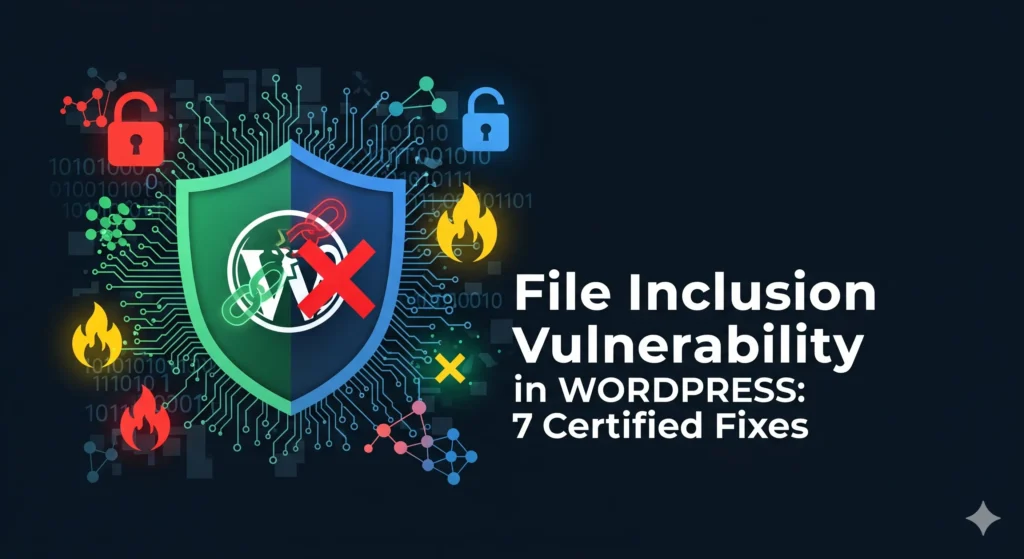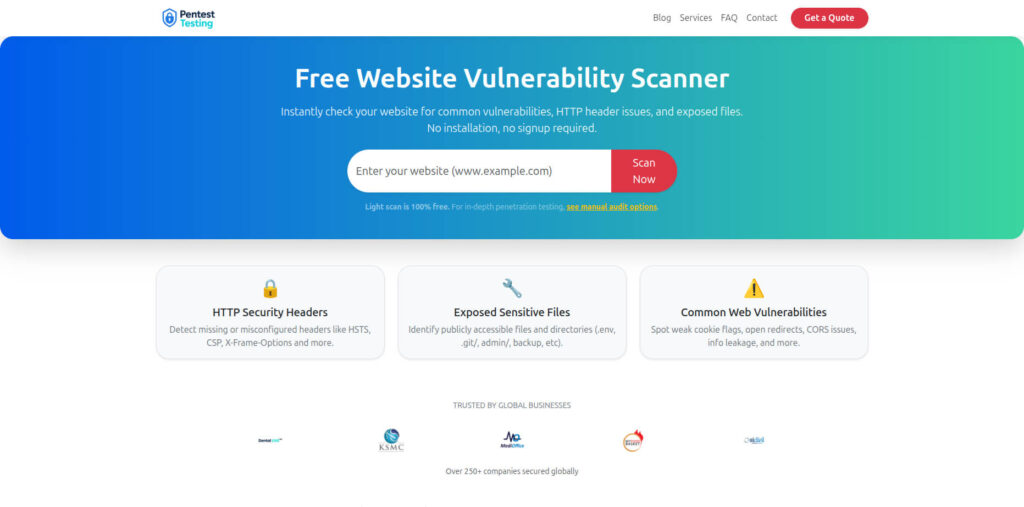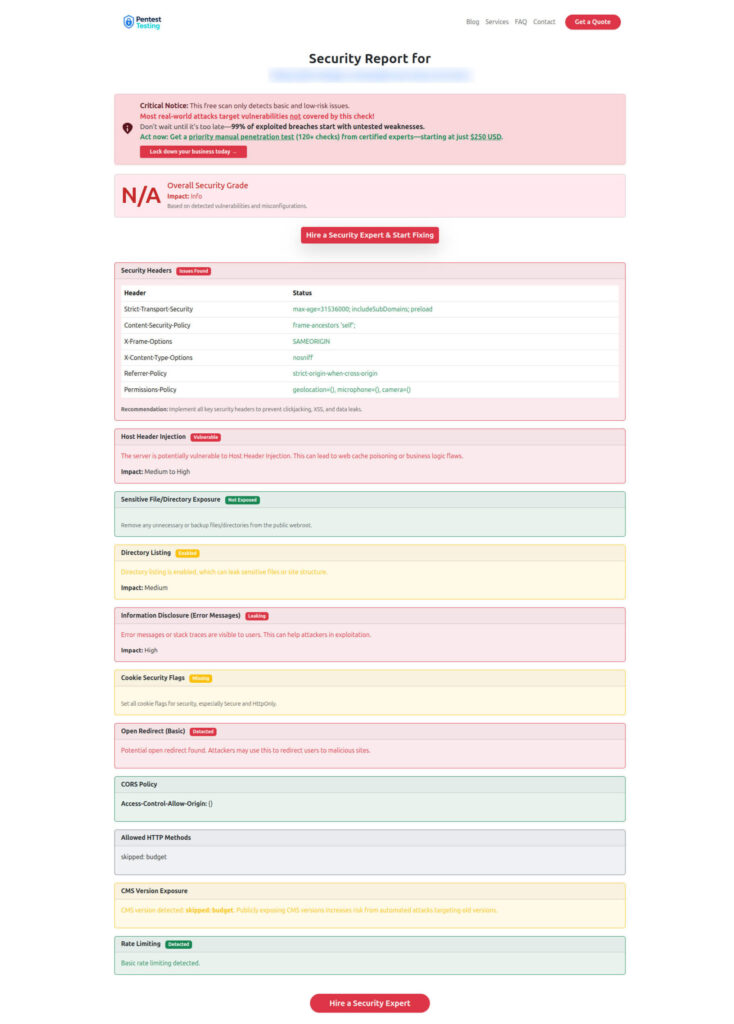File Inclusion Vulnerability in WordPress — A Practical, Developer-First Guide
If you manage plugins, themes, or custom code, you’ve likely heard warnings about File Inclusion Vulnerability in WordPress. It’s one of those bugs that hides in plain sight—one careless include or a too-trusting query string, and attackers can read sensitive files (LFI) or load remote code (RFI). In this in-depth guide, we’ll break down how File Inclusion Vulnerability in WordPress happens, show realistic (yet safe) examples, and share 7 proven fixes you can apply today—without breaking your site.

Why It Matters (and Where It Hides)
File Inclusion Vulnerability in WordPress usually appears when theme or plugin code uses include, require, include_once, or require_once with user-controlled input. Common anti-patterns:
- Dynamically including a PHP file based on
$_GET['page']. - Allowing directory traversal (e.g.,
../../wp-config.php). - Misusing stream wrappers (e.g.,
php://,data://) or leavingallow_url_includeenabled (RFI risk).
Attackers love it because it’s often trivial to exploit and yields high-value targets (configuration secrets, database credentials, arbitrary code execution if an upload bug also exists).
Quick Vocabulary (so we’re aligned)
- LFI (Local File Inclusion): Reading local files through an include path, e.g., leaking
/etc/passwdorwp-config.php. - RFI (Remote File Inclusion): Loading a remote script, usually possible if
allow_url_include=On(should always be Off). - Traversal: Using sequences like
../..to walk out of the intended directory.
You’ll see all three referenced when discussing File Inclusion Vulnerability in WordPress.
Vulnerable Pattern (Don’t Do This)
// BAD: functions.php or a custom plugin main file
// Example route: /?page=about.php OR /?page=../../wp-config.php
if ( isset($_GET['page']) ) {
$page = $_GET['page']; // untrusted
include get_stylesheet_directory() . '/templates/' . $page;
}A motivated attacker tries:
/?page=../../wp-config.php…and suddenly sensitive keys are exposed. That’s classic File Inclusion Vulnerability in WordPress.
Screenshot of our free website vulnerability scanner homepage

1) Safe Allow-List Includes (Primary Fix)
// GOOD: Only allow known templates (allow-list)
$templates = [
'home' => 'home.php',
'about' => 'about.php',
'faq' => 'faq.php',
];
$key = isset($_GET['page']) ? sanitize_key($_GET['page']) : 'home';
if (!array_key_exists($key, $templates)) {
$key = 'home';
}
$template_path = get_stylesheet_directory() . '/templates/' . $templates[$key];
// Optional: verify path resolves inside templates directory
$base = realpath(get_stylesheet_directory() . '/templates');
$real = realpath($template_path);
if ($real === false || strpos($real, $base) !== 0) {
wp_die(__('Invalid template path.', 'your-textdomain'));
}
include $real;Why this works: No arbitrary filenames. Even if a user supplies ../.., it won’t map to a key. This directly reduces the risk of File Inclusion Vulnerability in WordPress.
2) Use WordPress Loaders Instead of Raw include
If you’re loading parts of the theme, prefer core helpers:
// Instead of include $file, use get_template_part:
get_template_part('templates/faq'); // loads templates/faq.phpOr for plugin templates:
$template = locate_template(['my-plugin/single-item.php']);
if ($template) {
load_template($template, false);
}These reduce the temptation to pipe user input into file paths—a frequent cause of File Inclusion Vulnerability in WordPress.
3) Sanitize + Validate Every Input
Even if you’re not including files, safe handling reduces traversal risks elsewhere:
$page = isset($_GET['page']) ? sanitize_text_field(wp_unslash($_GET['page'])) : 'home';
// Optionally constrain to alphanumeric + dashes/underscores
if (!preg_match('/^[a-z0-9\-_]+$/i', $page)) {
$page = 'home';
}If you must map input to files, combine this with an allow-list. Validation alone isn’t enough for a File Inclusion Vulnerability in WordPress.
4) Lock Down PHP & Server Settings
php.ini / user.ini
; Always disable remote file inclusion
allow_url_include = Off
; Prefer Off to cut down remote fetch vectors
allow_url_fopen = Off
; Limit where PHP can access files
open_basedir = /var/www/html/:/tmp/Apache .htaccess (deny executing PHP in uploads and restrict sensitive files)
# No PHP execution in uploads
<Directory "/var/www/html/wp-content/uploads">
<FilesMatch "\.php$">
Deny from all
</FilesMatch>
</Directory>
# Block direct access to wp-config and hidden files
<FilesMatch "^(wp-config\.php|\.env|\.ht)">
Require all denied
</FilesMatch>Nginx (similar intent)
location ~* /wp-content/uploads/.*\.php$ { return 403; }
location ~* /(wp-config\.php|\.env|\.git|composer\.(json|lock)) { deny all; }These server rules significantly reduce the blast radius of any residual File Inclusion Vulnerability in WordPress.
5) Remove Traversal by Normalizing Paths
function inside_dir(string $baseDir, string $path): bool {
$base = realpath($baseDir);
$real = realpath($path);
return $real !== false && strpos($real, $base) === 0;
}
$baseDir = get_stylesheet_directory() . '/templates';
$requested = basename((string)($_GET['page'] ?? 'home')) . '.php';
$full = $baseDir . '/' . $requested;
if (!inside_dir($baseDir, $full) || !is_file($full)) {
$full = $baseDir . '/home.php';
}
include $full;This prevents “../../” traversal tricks that fuel File Inclusion Vulnerability in WordPress.
6) Least-Privilege Filesystem & WordPress Hardening
- File permissions:
wp-config.php→400or440. PHP files →640/644. Directories →750/755. - Disable editor: In
wp-config.php:define('DISALLOW_FILE_EDIT', true); - Disallow unfiltered HTML (on sites with multiple editors):
define('DISALLOW_UNFILTERED_HTML', true); - Restricted includes: Keep template and include files under a known directory with no write permissions for the web server user.
These changes don’t just mitigate File Inclusion Vulnerability in WordPress, they raise your overall WordPress security posture.
7) Automated Scanning + Code Review Workflow
- Static grep to find risky calls:
# Search themes/plugins for risky include/require usage grep -RIn --include="*.php" -E "include|require|include_once|require_once" wp-content/themes wp-content/plugins - Review any variable concatenation around includes and
fopen,file_get_contents,readfile, etc. - Run an external scan to catch public issues early.
Sample Assessment Report by our free scanner to

Use our free scanner at https://free.pentesttesting.com/ to spot exposed endpoints that could indicate File Inclusion Vulnerability in WordPress.
Safe Patterns You Can Reuse (Copy-Paste Ready)
A) Controller-Style Router with Strict Mapping
$routes = [
'dashboard' => 'dashboard.php',
'profile' => 'profile.php',
'orders' => 'orders.php',
];
$route = isset($_GET['r']) ? sanitize_key($_GET['r']) : 'dashboard';
$file = plugin_dir_path(__FILE__) . 'views/' . ($routes[$route] ?? 'dashboard.php');
if (!is_file($file)) {
status_header(404);
wp_die(__('Not found', 'your-td'));
}
load_template($file, false);B) Escape Everything on Output
$title = isset($_POST['title']) ? sanitize_text_field(wp_unslash($_POST['title'])) : '';
$profile = isset($_POST['profile_url']) ? esc_url_raw(wp_unslash($_POST['profile_url'])) : '';
printf('<h2>%s</h2>', esc_html($title));
printf('<a href="%s">%s</a>', esc_url($profile), esc_html($profile));Even though escaping won’t “fix” File Inclusion Vulnerability in WordPress, it prevents XSS chains that often ride alongside it. For more on XSS controls, see our post XSS Prevention in WordPress.
How to Test Safely (Local-Only)
Never test on production. In a local/staging clone:
- Search for
include/requireand check if any use request parameters directly. - Try visiting suspicious routes like
/?page=../../wp-config.php. - Confirm server rules block PHP in uploads and deny access to key files.
- Re-scan with our tool for website security check and validate the fix.
- Commit fixes and document the allow-list to help future maintainers avoid File Inclusion Vulnerability in WordPress.
Related Reading from Us (Strengthen Your Defenses)
- XSS Prevention in WordPress — Close cross-site scripting gaps that pair with include bugs.
- Directory Traversal Attack in WordPress — Prevent
../bugs that often precede LFI. - How to Secure Your OpenCart Store — If you also run OpenCart, this will help.
- Unrestricted File Upload in WordPress — 10 Proven Fixes (with code).
You can also see how we handle CSRF defenses on other stacks here: CSRF Prevention in Node.js (Cybersrely).
Service Playbooks (When You Need a Team)
Managed IT Services for Always-On Security
Keep patching, backups, monitoring, and incident readiness on rails with our Managed IT Services. We help you reduce exposure and keep File Inclusion Vulnerability in WordPress out of your SDLC.
AI Application Cybersecurity (Secure Your ML/AI Apps)
From prompt-injection to model supply chain risks, our AI Application Cybersecurity team secures modern apps that integrate with WordPress and beyond.
White-Label Cybersecurity for Your Clients
Agencies and MSPs: offer pentesting and remediation through Offer Cybersecurity Service to Your Client without building it from scratch.
Developer Checklist (Copy & Keep)
- Replace dynamic includes with allow-lists.
- Disable
allow_url_include; preferallow_url_fopen=Off. - Block PHP execution in
/uploads. - Normalize paths with
realpathand verify inside base dir. - Harden
wp-config.phpand file permissions. - Use
get_template_part/load_templateinstead of rawinclude. - Scan regularly with https://free.pentesttesting.com/ and code-review risky calls.
This checklist alone eliminates most File Inclusion Vulnerability in WordPress issues we encounter in the field.
Conclusion
Fixing File Inclusion Vulnerability in WordPress isn’t complicated—it’s disciplined:
- Allow-list templates, never include from raw input.
- Harden PHP & server rules to block traversal and RFI routes.
- Adopt WordPress loaders and sanitize everywhere.
- Scan, verify, and document so future changes don’t re-introduce it.
When you’re ready for a second set of eyes or want ongoing coverage, our team at Pentest Testing Corp can help—from rapid assessments to full remediation and managed security.
P.S. If you found this useful, also check our related posts on Directory Traversal in WordPress and XSS Prevention in WordPress—they pair perfectly with today’s fixes and help ensure File Inclusion Vulnerability in WordPress doesn’t sneak back in.
🔐 Frequently Asked Questions (FAQs)
Find answers to commonly asked questions about File Inclusion Vulnerability in WordPress.

